Where to Sell Antiques and Collectibles (Online and Offline)
updated on July 24,2024

Have you ever come across a beautiful antique or a rare collectible and wondered how you could sell it for a fair price? The world of antiques and collectibles is vast and fascinating, but navigating the marketplace to find the right buyers can be a challenging endeavour.
The global online sales in the art and antiques market witnessed a roughly 7% increase in 2023 compared to the previous year. Despite the pandemic, the overall value of online transactions in the global art and antiques market continued to remain significantly higher than the pre-COVID figures, reaching around $11.8 billion in 2023.
In this article, we will explore the diverse options for selling antiques and collectibles, guiding you through the process of finding the perfect platform to showcase your prized possessions.
Why Sell Antiques and Collectibles
Selling antiques and collectibles is an exciting endeavour that offers a multitude of reasons to engage in this market.
Potential for High Value
Antiques and collectibles have the potential to hold significant value, particularly when they are rare, in-demand, or associated with historical significance. By selling antiques and collectibles, you have the opportunity to tap into this potential for high value, unlocking the monetary worth of your items.
Unique and One-of-a-Kind Items
Antiques and collectibles items offer a glimpse into the past, representing craftsmanship, aesthetics, and historical periods that are often not replicated in contemporary production. By selling these unique pieces, you enable collectors and enthusiasts to own a tangible connection to history, adding a sense of exclusivity and individuality to their collections.
Passionate and Dedicated Market
The market for antiques and collectibles is characterised by a passionate and dedicated community of collectors and enthusiasts. These individuals are deeply invested in their areas of interest, seeking out specific items to enrich their collections. By engaging with this market, you have the opportunity to connect with like-minded individuals who appreciate and value the historical and cultural significance of these artefacts.
Diverse Range of Items
The world of antiques and collectibles encompasses a vast array of items, ranging from furniture, artwork, and jewellery to coins, stamps, and vintage toys. This diverse range ensures that there is a market for almost every type of item, catering to various interests and niches. Whether you specialise in a particular category or have a collection that spans different genres, the breadth of the market allows you to find buyers who appreciate the unique qualities of your offerings.
Eco-Friendly and Sustainable
Selling antiques and collectibles aligns with principles of sustainability and environmental consciousness. By trading pre-owned items, you contribute to the reduction of waste and the promotion of a circular economy. The reutilization of antiques and collectibles reduces the need for new production, minimising the ecological footprint associated with manufacturing processes.
| Get Started Now to Grow Your Online Business with the Best AliExpress Dropshipping Tool - DSers! |
Thrill of Discovery
One of the most exhilarating aspects of selling antiques and collectibles is the thrill of discovery. Exploring estate sales, flea markets, and online auctions can lead to unexpected encounters with hidden gems and overlooked treasures. The excitement and sense of adventure associated with the hunt for unique items add an element of intrigue to the selling process.
Potential for Profit
Beyond the inherent value of antiques and collectibles, there is also the potential for significant profit. If you possess expertise in assessing the market, identifying trends, and understanding the desires of collectors, you can strategically acquire items at lower prices and sell them at a premium.
Where to Sell Antiques and Collectibles
There are several types of online platforms that cater to selling antiques and collectibles. Here are some popular ones you can go through and know where and how to sell:
1. Shopify

Shopify is one of the leading e-commerce platforms for selling antiques online. With over 600,000 online stores and 1 million active users globally, Shopify is particularly well-suited for large businesses looking to establish an online presence for their antique sales. Let's check the great features of this platform.
Features
- Shopify allows users to create professional-looking, mobile-responsive online stores with a wide range of customizable themes and design options.
- Shopify provides built-in payment processing capabilities, including support for major credit cards, digital wallets, and alternative payment methods.
- The platform offers robust inventory management features, allowing users to track stock levels, create purchase orders, and generate detailed sales reports.
- Shopify integrates with various sales channels, including social media platforms, marketplaces like Amazon and eBay, and in-person point-of-sale systems.
- Shopify's analytics dashboard provides insights into customer behavior, sales performance, marketing effectiveness, and more.
- Shopify's App Store offers thousands of third-party apps and integrations to extend the platform's functionality, from accounting to shipping and fulfillment.
- Shopify's abandoned cart recovery feature helps merchants re-engage customers who have left items in their carts without completing a purchase.
- SEO and Marketing Tools: Shopify offers built-in search engine optimization (SEO) features and marketing tools to help merchants improve their online visibility and drive more traffic to their stores.
- Ease of Use: Shopify is known for its user-friendly interface and drag-and-drop website builder, making it accessible for users of all technical skill levels.
- Scalability: The platform can accommodate businesses of all sizes, from small startups to large enterprises, with its robust features and scalable plans.
- Extensive App Ecosystem: Shopify's App Store offers thousands of third-party integrations and apps to extend the platform's functionality.
- Reliable and Secure: Shopify provides a secure and reliable ecommerce infrastructure, with built-in SSL certificates and PCI-compliant payment processing.
- Multichannel Integration: Shopify allows merchants to sell across multiple channels, including social media, online marketplaces, and brick-and-mortar stores.
- Transaction Fees: Shopify charges transaction fees on top of payment processing fees, which can add up and cut into a merchant's profit margins.
- Limited Customization: While Shopify offers a wide range of themes and customization options, some users may find the level of customization limited compared to more flexible open-source platforms.
- Subscription-based Pricing: Shopify operates on a subscription-based model, which can be a disadvantage for merchants with seasonal or unpredictable sales volumes.
Pricing
Shopify offers a range of pricing plans to cater to businesses of all sizes and requirements. At the entry-level, the Shopify Lite plan is priced at $9 per month. For businesses seeking a more comprehensive ecommerce solution, the Basic Shopify plan is available at $29 per month.
2. eBay
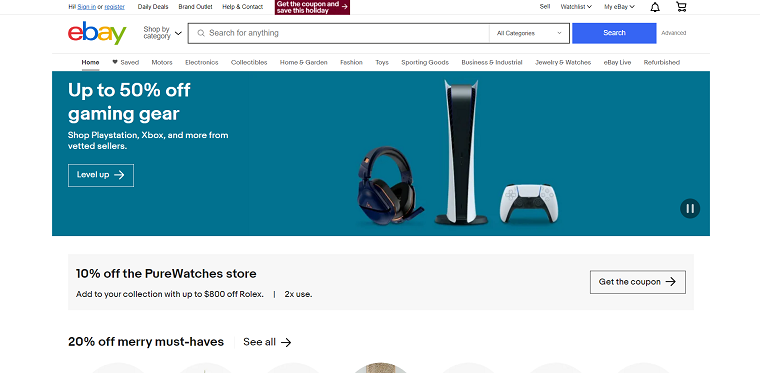
eBay is a popular online platform for buying and selling antiques and collectibles. Let’s know further about this profitable online platform:
Features
- eBay allows users to create detailed listings with descriptions, photos, and pricing for their antique or collectible items.
- Sellers can choose to list their items for auction, allowing potential buyers to bid on them.
- Alternatively, sellers can also set a fixed price for their items using the "Buy It Now" option, allowing buyers to purchase the item immediately.
- It has a wide international user base, which increases the potential for finding buyers for unique or rare items.
- eBay provides various seller tools, such as promotional options, shipping calculators, and customer support, to help sellers manage their listings effectively.
- eBay has millions of active users, giving sellers access to a broad audience and increasing the chances of finding buyers for their items.
- The auction format can generate excitement and competition among buyers, potentially resulting in higher selling prices for valuable or sought-after items.
- Sellers can choose between auction-style listings or fixed-price listings, allowing them to test different pricing strategies.
- eBay offers seller protection programs and policies to help mitigate risks associated with online transactions.
- eBay charges fees for listing items, selling them successfully, and for additional features such as promotional options.
- With a large number of sellers on eBay, the competition can be intense.
- Sellers need to exercise caution and follow eBay's guidelines for safe transactions.
Pricing
eBay's pricing structure includes several types of fees, including listing fees, final value fees, and optional fees for additional features. The specific fee amounts can vary depending on the item category, listing format (auction or fixed price), and any optional features selected by the seller. It is advisable to learn eBay sales tax as well to know the crucial insights helping you to make an informed decision.
3. Etsy
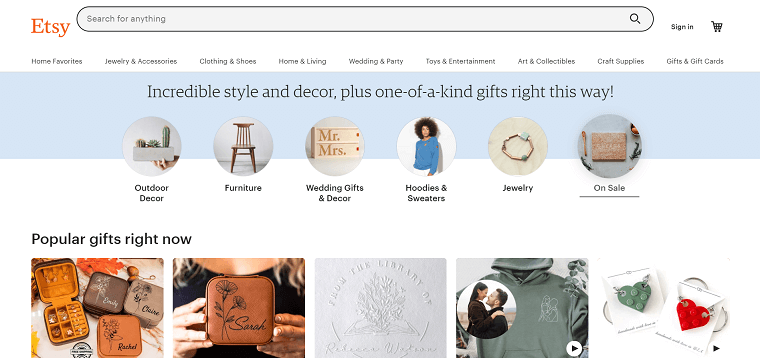
Etsy provides a niche marketplace with a focus on handmade and vintage items, making it an attractive platform for selling antiques and collectibles.
Features
- Etsy provides a dedicated marketplace for sellers to list and sell their antique and collectible items.
- Sellers can customise their shop on Etsy to reflect their branding and style.
- Etsy offers various search filters that help buyers find specific types of antiques and collectibles.
- Sellers can communicate directly with buyers through Etsy's messaging system.
- It has a strong community of sellers and buyers who share a passion for unique and handmade items.
- Etsy attracts buyers specifically interested in handmade, vintage, and unique items.
- It provides an easy-to-use interface for both sellers and buyers, allowing for a smooth selling experience.
- Sellers on Etsy can reach a global audience, expanding their potential customer base beyond their local area.
- Etsy offers various tools and resources to help sellers manage their shops effectively, including analytics, marketing options, and customer support.
- There is significant competition among sellers, requiring sellers to find ways to stand out and attract buyers.
- Etsy charges fees for listing items, transaction fees, and payment processing fees. Sellers should consider these fees when pricing their items.
- While Etsy has a dedicated section for antiques and collectibles, it may not have the same depth or breadth of selection as specialised antique marketplaces.
Pricing
Etsy's pricing structure includes listing fees, transaction fees, and payment processing fees. The listing fee is a flat fee for each item listed, and the transaction fee is a percentage of the item's sale price. Additionally, payment processing fees apply if sellers use Etsy's payment processing system.
4. Ruby Lane
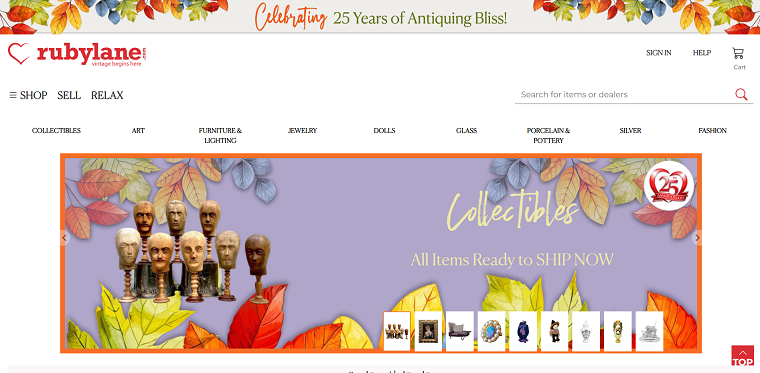
Ruby Lane is an online marketplace that specialises in antiques, collectibles, vintage items, and fine art.
Features
- Ruby Lane focuses on high-quality vintage and antique items.
- The marketplace hosts a wide range of categories, including jewellery, art, fashion, home decor, furniture, and more.
- Individual sellers have their own online shops on Ruby Lane, allowing them to create a personalised brand and showcase their items.
- Ruby Lane provides a secure environment for buyers and sellers, with features such as secure payment processing and fraud protection.
- The platform fosters a community of collectors, experts, and enthusiasts who can provide insights and information about the items being sold.
- Ruby Lane attracts a dedicated community of buyers who are specifically interested in vintage and antique items, increasing the chances of finding the right audience for your products.
- The platform has a strict vetting process for sellers and items, ensuring that the items listed are authentic and of high quality.
- Sellers can customise their own shops on Ruby Lane, adding a unique touch and branding to their listings.
- Ruby Lane encourages communication and interaction between sellers and buyers, fostering a sense of community and trust.
- Platform is not suitable for sellers looking to sell other types of products as it focuses on vintage and antique items only.
- Ruby Lane may have a smaller audience compared to larger generalist platforms, potentially limiting the exposure of your items.
- The fees associated with selling on Ruby Lane can be higher compared to other platforms. However, this is offset by the targeted audience and specialised nature of the marketplace.
Pricing
Ruby Lane has a tiered fee structure for sellers. The basic fees include a setup fee for new sellers, a monthly maintenance fee, and a per-item listing fee. Additionally, there is a commission fee based on the final sale price of the item. The exact pricing details may change over time, so it is advisable to visit the Ruby Lane website or contact their customer support for the most up-to-date pricing information.
5. Online Auction Sites
LiveAuctioneers and Proxibid are two popular online auction platforms that provide a virtual marketplace for buying and selling high-value items through live or timed auctions. Here is an introduction to these auction platforms and their advantages:
LiveAuctioneers
LiveAuctioneers is an online auction platform that connects buyers and sellers from around the world. It specialises in live bidding, allowing participants to place bids in real-time during the auction event. Here are some benefits of using LiveAuctioneers for high-value items:
- LiveAuctioneers has a large user base, attracting bidders from various countries.
- Global audience increases the exposure of high-value items and attracts potential buyers.
- The live format of auctions creates a competitive bidding environment. This can lead to higher prices and better returns for sellers of high-value items.
- LiveAuctioneers partners with reputable auction houses and galleries, which adds credibility and expertise to the platform. This can help attract serious collectors and investors who are specifically looking for high-value items.
Proxibid
Proxibid is another well-known online auction platform that facilitates live and timed auctions. It provides a secure online environment for buying and selling a wide range of high-value items. Here are some benefits of using Proxibid:
- Proxibid prioritises secure transactions by offering fraud protection and escrow services.
- It has a stringent vetting process for sellers, verifying their credentials and ensuring that they meet certain standards.
- It lets participants bid remotely from anywhere with an internet connection.
- Its flexibility enables potential buyers to participate in auctions for high-value items without the need to physically attend the auction event.
Tips for Selling on Online Platforms Successfully
- Provide a detailed and accurate description of the item, including its history, age, condition, materials, dimensions, and any unique features or markings.
- Take clear, well-lit photos that showcase the item from multiple angles.
- Conduct research to identify keywords and phrases that potential buyers might use when searching for similar items. Incorporate these keywords naturally into your title and item description to enhance visibility in search results.
- Research the market value of similar items to determine a competitive and fair price.
- Share any historical information, background stories, or provenance associated with the item.
- Promote your listings on social media platforms and relevant online communities dedicated to antiques and collectibles.
- Engage with potential buyers, share interesting facts or stories about the item, and build a reputation as a knowledgeable and trustworthy seller.
- Respond to inquiries and messages from potential buyers in a timely manner.
- If your item comes with any certificates of authenticity or has been appraised by experts, include this information in your listing.
- Emphasise the quality and craftsmanship of the item to instil buyer confidence.
By implementing these tips, you can effectively list and market your antiques and collectibles on online platforms, improving your chances of attracting the right buyers and achieving successful sales.
Offline Options for Selling Antiques
Selling antiques and collectibles through offline channels can be a rewarding and effective way to reach local buyers. Here are some options and tips to make an informed decision:
Antique Shops and Consignment Stores
Advantages
Antique shops and consignment stores provide a dedicated space for displaying and selling your items. They often have an established customer base and may actively promote your items. These establishments typically have staff with expertise in antiques, who can help with pricing and marketing.
Considerations
Some shops may require a commission or a monthly fee for displaying your items. It's important to research and choose reputable establishments that attract the right target audience for your specific items.
Flea Markets and Vintage Fairs
Advantages
Flea markets and vintage fairs offer a lively and interactive environment where you can directly engage with potential buyers. You have the opportunity to showcase your items, negotiate prices, and provide additional information or history about the pieces. These events often attract a diverse range of buyers, including collectors and enthusiasts.
Considerations
While there is potential for high foot traffic, the success of selling at these events can vary. Factors such as location, timing, and competition from other vendors can impact your sales. It's essential to choose events with a target audience interested in your specific items.
Estate Sales and Auctions
Advantages
Estate sales often involve selling the entire contents of a home or collection, which means you can showcase a wide range of items and attract a diverse group of buyers. It tends to attract serious collectors, dealers, and enthusiasts who are actively seeking unique items.
This can increase the chances of finding interested buyers and fetching competitive prices. Estate sale companies specialise in organising and managing these sales. They handle advertising, pricing, staging, and conducting the sale, which can save you time and effort. They also have the expertise to accurately appraise items and set appropriate prices.
Considerations
Estate sales and auctions typically require advance planning and coordination. You may need to work with estate sale companies or auction houses, who will handle the logistics, marketing, and pricing. Keep in mind that there may be fees or commissions associated with these services.
Tips for Successfully Selling Through Local Channels
- Pricing: Research the market value of your items by consulting price guides, online marketplaces, or seeking professional appraisals. Price your items competitively, considering their condition, rarity, and demand.
- Presentation: Ensure your items are clean, well-maintained, and appropriately displayed. Use proper lighting and attractive arrangements to make them visually appealing. Provide accurate descriptions, including any relevant historical or provenance information.
- Networking: Build connections within the local antique and collector community. Attend events, join associations, and participate in relevant social media groups or forums. Networking can help you gain visibility, knowledge, and potential buyers.
Remember to document your items with clear photographs and detailed descriptions, both for your own records and for potential buyers. Also, consider offering multiple payment options, such as cash, card, or online transfers, to accommodate different buyer preferences.
Final Words
The world of buying and selling antiques and collectibles offers a multitude of options, both online and offline. Whether you choose to embrace the convenience of online platforms or enjoy the traditional experience of brick-and-mortar stores and auctions, there are various avenues available to cater to your specific needs.





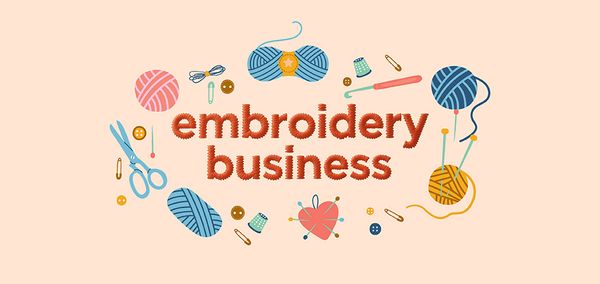

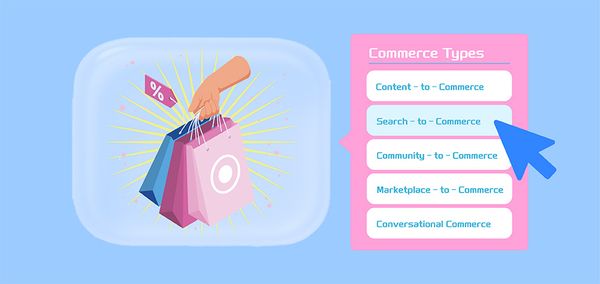





 Company
Company
 Why Choose DSers
Why Choose DSers
 Blog
Blog
 Help Center
Help Center




 Live Chat
Live Chat